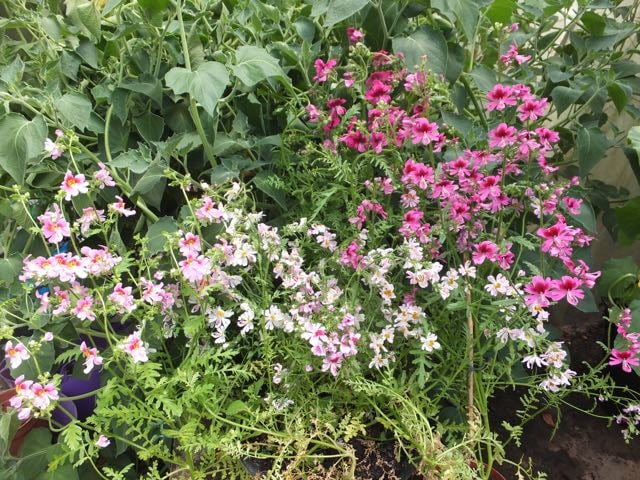
Also known as Fringe flowers and Poor man’s orchids Schizanthus are a glorious way of filling a glasshouse with summer colour. Coming from S. America this small genus related to potatoes derives both common and scientific names from pretty pansy like blooms. These have split corollas and look much like orchids, and even more like brightly patterned butterflies with fringed wings. Likewise the Latin Shiz, means split, and anthus, flower.
You can have masses as these are annuals simply grown from packet seed much like tomatoes or peppers under cover in warmth in spring. Ideally sow one or two seeds apiece in small pots, cells or modules, though you could sow in a tray and prick out later. Keep the seedlings warm but not too warm or they get leggy, indeed treat them just like young peppers. Tie them to small sticks to keep them upright. Most of all keep them in bright light as these love the sun.
Pot on once or twice and by early summer have the young plants in ½ litre pots or several to a larger container. Water sparingly from when tiny and only feed when the young plants look pale, then once the first flowers appear reduce feeding but keep on watering. A light liquid feed once weekly will benefit flagging plants into a longer display. Remember though, being annual their demise is certain, and this conveniently makes space just when needed for plants coming under cover for winter.
Seemingly immune to pests and diseases, tolerating a wide range of composts and watering regimes Schizanthus are not at all difficult in any way. That is save for their distinct tendency to floppiness. Although modern varieties are more compact they still tend to get leggy, then floppy and break. Thus although they could be wonderful outdoors in a summer border or hanging from a basket their ferny foliage and delicate flowers means they’re finer under cover.
There are some improved strains with bigger flowers and even more variations in colour though few other species for the collector. Modern Schizanthus have been developed from the original hybrid between the Chilean S. pinnata with lilac or violet flowers and S. retusus with red flowers.
Oddly these are also good plants for children on a windowsill as they’re quick to give such pretty flowers regardless and repay better treatment magnificently. The ‘old boys’ would sow in early autumn, over-winter the plants to force in spring. And with much nipping out and training produce mounds of blossoms a yard or more high and up to a dozen feet around. So you can start end of next month, order that seed!










